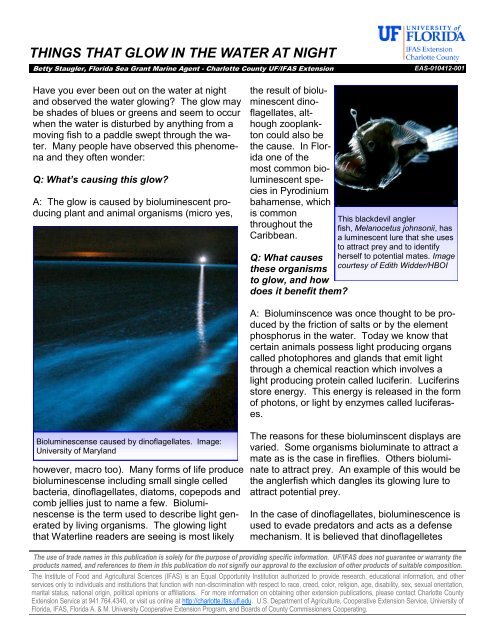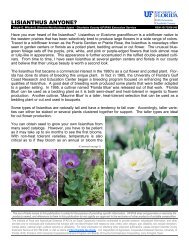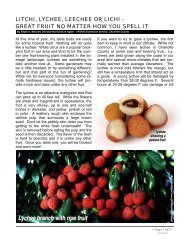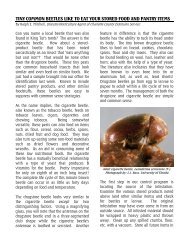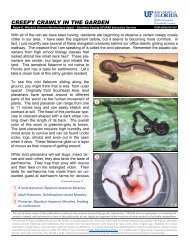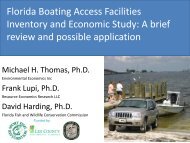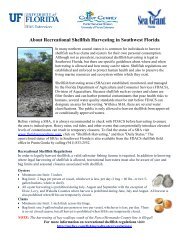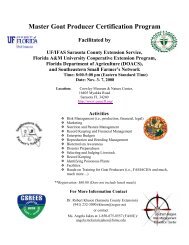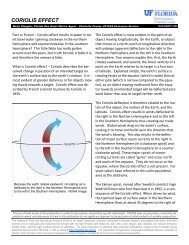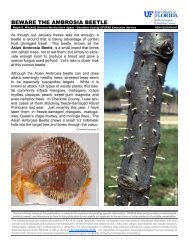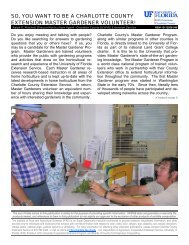things that glow in the water at night - Charlotte County Cooperative ...
things that glow in the water at night - Charlotte County Cooperative ...
things that glow in the water at night - Charlotte County Cooperative ...
You also want an ePaper? Increase the reach of your titles
YUMPU automatically turns print PDFs into web optimized ePapers that Google loves.
THINGS THAT GLOW IN THE WATER AT NIGHT<br />
Betty Staugler, Florida Sea Grant Mar<strong>in</strong>e Agent - <strong>Charlotte</strong> <strong>County</strong> UF/IFAS Extension<br />
EAS-010412-001<br />
Have you ever been out on <strong>the</strong> <strong>w<strong>at</strong>er</strong> <strong>at</strong> <strong>night</strong><br />
and observed <strong>the</strong> <strong>w<strong>at</strong>er</strong> <strong>glow</strong><strong>in</strong>g The <strong>glow</strong> may<br />
be shades of blues or greens and seem to occur<br />
when <strong>the</strong> <strong>w<strong>at</strong>er</strong> is disturbed by anyth<strong>in</strong>g from a<br />
mov<strong>in</strong>g fish to a paddle swept through <strong>the</strong> <strong>w<strong>at</strong>er</strong>.<br />
Many people have observed this phenomena<br />
and <strong>the</strong>y often wonder:<br />
Q: Wh<strong>at</strong>’s caus<strong>in</strong>g this <strong>glow</strong><br />
A: The <strong>glow</strong> is caused by biolum<strong>in</strong>escent produc<strong>in</strong>g<br />
plant and animal organisms (micro yes,<br />
<strong>the</strong> result of biolum<strong>in</strong>escent<br />
d<strong>in</strong>oflagell<strong>at</strong>es,<br />
although<br />
zooplankton<br />
could also be<br />
<strong>the</strong> cause. In Florida<br />
one of <strong>the</strong><br />
most common biolum<strong>in</strong>escent<br />
species<br />
<strong>in</strong> Pyrod<strong>in</strong>ium<br />
bahamense, which<br />
is common<br />
throughout <strong>the</strong><br />
Caribbean.<br />
Q: Wh<strong>at</strong> causes<br />
<strong>the</strong>se organisms<br />
to <strong>glow</strong>, and how<br />
does it benefit <strong>the</strong>m<br />
This blackdevil angler<br />
fish, Melanocetus johnsonii, has<br />
a lum<strong>in</strong>escent lure <strong>th<strong>at</strong></strong> she uses<br />
to <strong>at</strong>tract prey and to identify<br />
herself to potential m<strong>at</strong>es. Image<br />
courtesy of Edith Widder/HBOI<br />
A: Biolum<strong>in</strong>scence was once thought to be produced<br />
by <strong>the</strong> friction of salts or by <strong>the</strong> element<br />
phosphorus <strong>in</strong> <strong>the</strong> <strong>w<strong>at</strong>er</strong>. Today we know <strong>th<strong>at</strong></strong><br />
certa<strong>in</strong> animals possess light produc<strong>in</strong>g organs<br />
called photophores and glands <strong>th<strong>at</strong></strong> emit light<br />
through a chemical reaction which <strong>in</strong>volves a<br />
light produc<strong>in</strong>g prote<strong>in</strong> called lucifer<strong>in</strong>. Lucifer<strong>in</strong>s<br />
store energy. This energy is released <strong>in</strong> <strong>the</strong> form<br />
of photons, or light by enzymes called luciferases.<br />
Biolum<strong>in</strong>escense caused by d<strong>in</strong>oflagell<strong>at</strong>es. Image:<br />
University of Maryland<br />
however, macro too). Many forms of life produce<br />
biolum<strong>in</strong>escense <strong>in</strong>clud<strong>in</strong>g small s<strong>in</strong>gle celled<br />
bacteria, d<strong>in</strong>oflagell<strong>at</strong>es, di<strong>at</strong>oms, copepods and<br />
comb jellies just to name a few. Biolum<strong>in</strong>escense<br />
is <strong>the</strong> term used to describe light gener<strong>at</strong>ed<br />
by liv<strong>in</strong>g organisms. The <strong>glow</strong><strong>in</strong>g light<br />
<strong>th<strong>at</strong></strong> W<strong>at</strong>erl<strong>in</strong>e readers are see<strong>in</strong>g is most likely<br />
The reasons for <strong>the</strong>se biolum<strong>in</strong>scent displays are<br />
varied. Some organisms biolum<strong>in</strong><strong>at</strong>e to <strong>at</strong>tract a<br />
m<strong>at</strong>e as is <strong>the</strong> case <strong>in</strong> fireflies. O<strong>the</strong>rs biolum<strong>in</strong><strong>at</strong>e<br />
to <strong>at</strong>tract prey. An example of this would be<br />
<strong>the</strong> anglerfish which dangles its <strong>glow</strong><strong>in</strong>g lure to<br />
<strong>at</strong>tract potential prey.<br />
In <strong>the</strong> case of d<strong>in</strong>oflagell<strong>at</strong>es, biolum<strong>in</strong>escence is<br />
used to evade pred<strong>at</strong>ors and acts as a defense<br />
mechanism. It is believed <strong>th<strong>at</strong></strong> d<strong>in</strong>oflagelletes<br />
The use of trade names <strong>in</strong> this public<strong>at</strong>ion is solely for <strong>the</strong> purpose of provid<strong>in</strong>g specific <strong>in</strong>form<strong>at</strong>ion. UF/IFAS does not guarantee or warranty <strong>the</strong><br />
products named, and references to <strong>the</strong>m <strong>in</strong> this public<strong>at</strong>ion do not signify our approval to <strong>the</strong> exclusion of o<strong>the</strong>r products of suitable composition.<br />
The Institute of Food and Agricultural Sciences (IFAS) is an Equal Opportunity Institution authorized to provide research, educ<strong>at</strong>ional <strong>in</strong>form<strong>at</strong>ion, and o<strong>the</strong>r<br />
services only to <strong>in</strong>dividuals and <strong>in</strong>stitutions <strong>th<strong>at</strong></strong> function with non-discrim<strong>in</strong><strong>at</strong>ion with respect to race, creed, color, religion, age, disability, sex, sexual orient<strong>at</strong>ion,<br />
marital st<strong>at</strong>us, n<strong>at</strong>ional orig<strong>in</strong>, political op<strong>in</strong>ions or affili<strong>at</strong>ions. For more <strong>in</strong>form<strong>at</strong>ion on obta<strong>in</strong><strong>in</strong>g o<strong>the</strong>r extension public<strong>at</strong>ions, please contact <strong>Charlotte</strong> <strong>County</strong><br />
Extension Service <strong>at</strong> 941.764.4340, or visit us onl<strong>in</strong>e <strong>at</strong> http://charlotte.ifas.ufl.edu. U.S. Department of Agriculture, Cooper<strong>at</strong>ive Extension Service, University of<br />
Florida, IFAS, Florida A. & M. University Cooper<strong>at</strong>ive Extension Program, and Boards of <strong>County</strong> Commissioners Cooper<strong>at</strong><strong>in</strong>g.
THINGS THAT GLOW IN THE WATER AT NIGHT<br />
January 4, 2012<br />
produce light when disturbed and will give a light<br />
flash last<strong>in</strong>g a fraction of a second. The flash is<br />
meant to <strong>at</strong>tract a pred<strong>at</strong>or to <strong>the</strong> cre<strong>at</strong>ure disturb<strong>in</strong>g<br />
or try<strong>in</strong>g to consume <strong>the</strong> d<strong>in</strong>oflagell<strong>at</strong>e.<br />
The light flash also surprises <strong>the</strong> pred<strong>at</strong>or caus<strong>in</strong>g<br />
it to worry about o<strong>the</strong>r pred<strong>at</strong>ors <strong>at</strong>tack<strong>in</strong>g it,<br />
mak<strong>in</strong>g <strong>the</strong> pred<strong>at</strong>or less likely to prey on <strong>the</strong> d<strong>in</strong>oflagell<strong>at</strong>e.<br />
Q: Are <strong>the</strong>re o<strong>the</strong>r phenomena <strong>th<strong>at</strong></strong> can cause<br />
similar effects For example, wh<strong>at</strong> about<br />
high levels of phosphorus <strong>in</strong> <strong>the</strong> <strong>w<strong>at</strong>er</strong><br />
A: Phosphorus <strong>in</strong> <strong>the</strong> <strong>w<strong>at</strong>er</strong> by itself does not<br />
produce a <strong>glow</strong><strong>in</strong>g effect; however, high concentr<strong>at</strong>ions<br />
of nutrients and <strong>in</strong> particular phosphorus<br />
would <strong>in</strong>crease <strong>the</strong> popul<strong>at</strong>ion of d<strong>in</strong>oflagell<strong>at</strong>es.<br />
Although most <strong>glow</strong>s <strong>in</strong><br />
<strong>the</strong> <strong>w<strong>at</strong>er</strong> are <strong>the</strong> result<br />
of biolum<strong>in</strong>escence,<br />
some organisms have<br />
<strong>the</strong> ability to fluoresce.<br />
Fluorescence is<br />
similar to biolum<strong>in</strong>escence<br />
but <strong>the</strong> trigger is<br />
changed. Instead of<br />
lucifer<strong>in</strong> and luciferase,<br />
Lob<strong>at</strong>e ctenophores (comb<br />
jellies) are translucent and<br />
give off a biolum<strong>in</strong>escent<br />
<strong>glow</strong>. Bol<strong>in</strong>opsis <strong>in</strong>fundibulum.<br />
Picture: OAR/N<strong>at</strong>ional<br />
Undersea Research Program<br />
(NURP) High resolution<br />
(Credit: NOAA)<br />
fluorescence is triggered<br />
when a pigment<br />
absorbs light from an<br />
outside source. Fluorescence<br />
is able to<br />
produce <strong>the</strong> widest<br />
spectrum of colors because<br />
<strong>the</strong> emitted color<br />
is determ<strong>in</strong>ed by <strong>the</strong> fluorescent pigment<br />
which absorbs <strong>the</strong> <strong>in</strong>com<strong>in</strong>g light. In <strong>the</strong> case of<br />
fluorescence, <strong>the</strong> emitted light is only visible<br />
while <strong>the</strong> trigger is present. Phosphorescence is<br />
similar to fluorescence except <strong>th<strong>at</strong></strong> <strong>the</strong> excited<br />
product is more stable, so <strong>the</strong> <strong>glow</strong> will last after<br />
<strong>the</strong> trigger has been removed. Glow <strong>in</strong> <strong>the</strong> dark<br />
stickers phosphoresce.<br />
Q: Are <strong>the</strong>re any harmful effects to o<strong>the</strong>r mar<strong>in</strong>e<br />
life, or <strong>th<strong>at</strong></strong> anglers and bo<strong>at</strong>ers should<br />
be concerned about Is it OK to e<strong>at</strong> fish<br />
caught from areas where <strong>the</strong> <strong>w<strong>at</strong>er</strong> is <strong>glow</strong><strong>in</strong>g<br />
A: Lum<strong>in</strong>escence does not pose a health issue,<br />
but some biolum<strong>in</strong>escent species can produce<br />
tox<strong>in</strong>s, <strong>in</strong>clud<strong>in</strong>g Pyrod<strong>in</strong>ium bahamense. These<br />
tox<strong>in</strong>s can be bioaccumul<strong>at</strong>ed <strong>in</strong> <strong>the</strong> food<br />
web. The specific thre<strong>at</strong> to health varies between<br />
ecosystems. It’s important to note <strong>th<strong>at</strong></strong> d<strong>in</strong>oflagell<strong>at</strong>es<br />
comprise a very large group of approxim<strong>at</strong>ely<br />
2000 different species and of <strong>the</strong>se<br />
only a very small percentage are toxic. D<strong>in</strong>oflagell<strong>at</strong>es<br />
are important primary producers. They<br />
fuel food webs, provid<strong>in</strong>g food for zooplankton,<br />
which feed small fish and so on. It is said <strong>th<strong>at</strong></strong><br />
photoplankton produce most of <strong>the</strong> earth’s oxygen.<br />
Q: Why does <strong>the</strong> <strong>glow</strong> seem to be most prevalent<br />
<strong>in</strong> summer, and why is <strong>the</strong> <strong>glow</strong> sometimes<br />
very bright and <strong>in</strong>tense, o<strong>the</strong>r times<br />
very muted<br />
A: You might see <strong>in</strong>creases <strong>in</strong> summer months<br />
because this could correspond to when <strong>the</strong>se<br />
biolum<strong>in</strong>escent organisms are reproduc<strong>in</strong>g<br />
(n<strong>at</strong>ural life cycles), or because summertime is<br />
when we have <strong>in</strong>creased fresh<strong>w<strong>at</strong>er</strong> runoff from<br />
ra<strong>in</strong>s result<strong>in</strong>g <strong>in</strong> more nutrients be<strong>in</strong>g flushed<br />
<strong>in</strong>to <strong>the</strong> systems which <strong>in</strong> turn can lead to more<br />
blooms of <strong>the</strong>se organisms. As far as <strong>in</strong>tensity<br />
of <strong>the</strong> <strong>glow</strong><strong>in</strong>g, <strong>the</strong> <strong>in</strong>tensity of <strong>the</strong> biolum<strong>in</strong>escence<br />
depends on <strong>the</strong> <strong>in</strong>tensity of <strong>the</strong> bloom and<br />
<strong>the</strong> health of <strong>the</strong> algae <strong>in</strong> <strong>the</strong> bloom.<br />
BETTY STAUGLER<br />
Florida Sea Grant Mar<strong>in</strong>e Agent<br />
Staugler@ufl.edu<br />
CHARLOTTE COUNTY UF/IFAS EXTENSION<br />
25550 Harbor View Road, Suite 3 - Port <strong>Charlotte</strong>, Florida 33980<br />
941.764.4340 - 941.764.4343 (fax) - http://charlotte.ifas.ufl.edu


